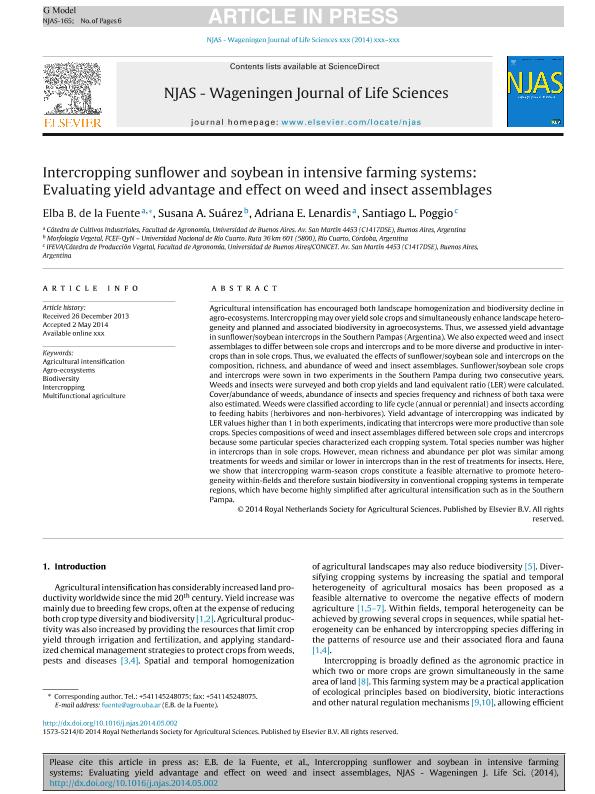Mostrar el registro sencillo del ítem
dc.contributor.author
de la Fuente, Elba Beatriz
dc.contributor.author
Suárez, Susana A.
dc.contributor.author
Lenardis, Adriana Ester
dc.contributor.author
Poggio, Santiago Luis

dc.date.available
2016-02-22T17:12:53Z
dc.date.issued
2014-05
dc.identifier.citation
de la Fuente, Elba Beatriz; Suárez, Susana A.; Lenardis, Adriana Ester; Poggio, Santiago Luis; Intercropping sunflower and soybean in intensive farming systems: evaluating yield advantage and effect on weed and insect assemblages; Elsevier; Njas - Wageningen Journal of Life Sciences; 70-71; 5-2014; 47-52
dc.identifier.issn
1573-5214
dc.identifier.uri
http://hdl.handle.net/11336/4340
dc.description.abstract
Agricultural intensification has encouraged both landscape homogenization and biodiversity decline inagro-ecosystems. Intercropping may over yield sole crops and simultaneously enhance landscape hetero-geneity and planned and associated biodiversity in agroecosystems. Thus, we assessed yield advantagein sunflower/soybean intercrops in the Southern Pampas (Argentina). We also expected weed and insectassemblages to differ between sole crops and intercrops and to be more diverse and productive in inter-crops than in sole crops. Thus, we evaluated the effects of sunflower/soybean sole and intercrops on thecomposition, richness, and abundance of weed and insect assemblages. Sunflower/soybean sole cropsand intercrops were sown in two experiments in the Southern Pampa during two consecutive years.Weeds and insects were surveyed and both crop yields and land equivalent ratio (LER) were calculated.Cover/abundance of weeds, abundance of insects and species frequency and richness of both taxa werealso estimated. Weeds were classified according to life cycle (annual or perennial) and insects accordingto feeding habits (herbivores and non-herbivores). Yield advantage of intercropping was indicated byLER values higher than 1 in both experiments, indicating that intercrops were more productive than solecrops. Species compositions of weed and insect assemblages differed between sole crops and intercropsbecause some particular species characterized each cropping system. Total species number was higherin intercrops than in sole crops. However, mean richness and abundance per plot was similar amongtreatments for weeds and similar or lower in intercrops than in the rest of treatments for insects. Here,we show that intercropping warm-season crops constitute a feasible alternative to promote hetero-geneity within-fields and therefore sustain biodiversity in conventional cropping systems in temperateregions, which have become highly simplified after agricultural intensification such as in the SouthernPampa.
dc.format
application/pdf
dc.language.iso
eng
dc.publisher
Elsevier

dc.rights
info:eu-repo/semantics/openAccess
dc.rights.uri
https://creativecommons.org/licenses/by-nc-nd/2.5/ar/
dc.subject
Agricultural Intensification
dc.subject
Agroecosystems
dc.subject
Biodiversity
dc.subject
Intercropping
dc.subject
Multifunctional Agriculture
dc.subject.classification
Conservación de la Biodiversidad

dc.subject.classification
Ciencias Biológicas

dc.subject.classification
CIENCIAS NATURALES Y EXACTAS

dc.subject.classification
Ecología

dc.subject.classification
Ciencias Biológicas

dc.subject.classification
CIENCIAS NATURALES Y EXACTAS

dc.subject.classification
Agricultura

dc.subject.classification
Agricultura, Silvicultura y Pesca

dc.subject.classification
CIENCIAS AGRÍCOLAS

dc.title
Intercropping sunflower and soybean in intensive farming systems: evaluating yield advantage and effect on weed and insect assemblages
dc.type
info:eu-repo/semantics/article
dc.type
info:ar-repo/semantics/artículo
dc.type
info:eu-repo/semantics/publishedVersion
dc.date.updated
2016-03-30 10:35:44.97925-03
dc.journal.volume
70-71
dc.journal.pagination
47-52
dc.journal.pais
Países Bajos

dc.journal.ciudad
Amsterdam
dc.description.fil
Fil: de la Fuente, Elba Beatriz. Universidad de Buenos Aires. Facultad de Agronomía. Departamento de Producción Vegetal. Cátedra de Cultivos Industriales; Argentina
dc.description.fil
Fil: Suárez, Susana A.. Universidad Nacional de Río Cuarto. Facultad de Agronomía y Veterinaria. Departamento de Biología Agrícola. Cátedra de Morfología Vegetal; Argentina
dc.description.fil
Fil: Lenardis, Adriana Ester. Universidad de Buenos Aires. Facultad de Agronomía. Departamento de Producción Vegetal. Cátedra de Cultivos Industriales; Argentina
dc.description.fil
Fil: Poggio, Santiago Luis. Consejo Nacional de Investigaciones Científicas y Técnicas. Oficina de Coordinación Administrativa Parque Centenario. Instituto de Investigaciones Fisiológicas y Ecológicas Vinculadas a la Agricultura; Argentina. Universidad de Buenos Aires. Facultad de Agronomía. Departamento de Producción Vegetal; Argentina
dc.journal.title
Njas - Wageningen Journal of Life Sciences

dc.relation.alternativeid
info:eu-repo/semantics/altIdentifier/url/http://www.sciencedirect.com/science/article/pii/S1573521414000207
dc.relation.alternativeid
info:eu-repo/semantics/altIdentifier/doi/http://dx.doi.org/10.1016/j.njas.2014.05.002
Archivos asociados
